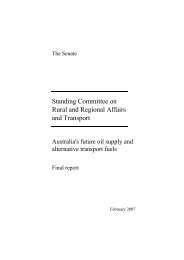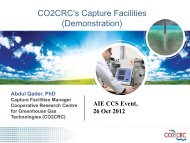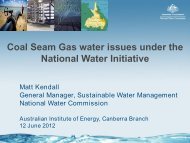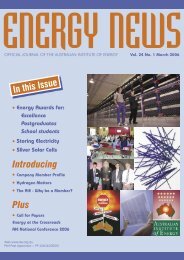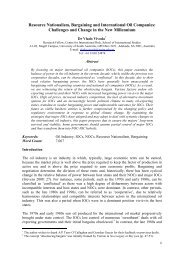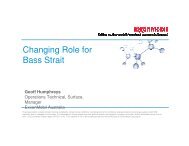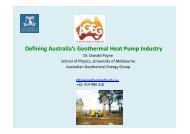Jun 2007 - Australian Institute of Energy
Jun 2007 - Australian Institute of Energy
Jun 2007 - Australian Institute of Energy
Create successful ePaper yourself
Turn your PDF publications into a flip-book with our unique Google optimized e-Paper software.
M2M provides a useful opportunity to learn about leading<br />
developments in this new field. As part <strong>of</strong> its involvement in<br />
the partnership, the <strong>Australian</strong> Government is working with<br />
the intensive livestock industries and the Rural Industries<br />
Research and Development Corporation, to develop and<br />
adapt technologies that capture and use methane. The<br />
expo’s agriculture program will focus on the global status <strong>of</strong><br />
anaerobic digestion <strong>of</strong> livestock waste. Topics may include<br />
the economics <strong>of</strong> anaerobic digestion as a pollution control<br />
alternative, pr<strong>of</strong>iles <strong>of</strong> existing projects, examples <strong>of</strong> national<br />
programs that develop sustainable markets and mechanisms<br />
for deploying anaerobic digestion technologies, examples <strong>of</strong><br />
emerging waste management and pollution control programs,<br />
rural household/small-scale digesters and gas uses, unheated<br />
covered lagoons for milder climates, and digesters using<br />
co-mingled waste and centralized operation.<br />
OIL AND GAS SYSTEMS<br />
The expo will cover all aspects <strong>of</strong> worldwide reductions<br />
in methane emissions from oil and gas systems, especially<br />
those located in China. There will also be a technical program<br />
focused on policy and regulatory issues such as carbon<br />
markets, and low methane emissions pipeline maintenance<br />
and repair technologies.<br />
FURTHER INFORMATION<br />
For more information about the Methane to Markets<br />
Partnership and the Beijing Expo, please visit http://www.<br />
methanetomarkets.org/<br />
You can join the partnership’s voluntary and free project<br />
network online at http://www.methanetomarkets.org/<br />
partners/network/index.htm<br />
The <strong>Australian</strong> Government is coordinating <strong>Australian</strong><br />
involvement in the expo and providing information and<br />
advice to <strong>Australian</strong> companies and researchers who are<br />
attending. For more information about the <strong>Australian</strong><br />
Government’s involvement, please contact Saravan Peacock<br />
at saravan.peacock@environment.gov.au/<br />
Science writers focus on energy<br />
By Joy Claridge, Editor, AIE<br />
<strong>Energy</strong> was a key topic at the 5th World Conference <strong>of</strong> Science<br />
Journalists held in Melbourne on 16–20 April <strong>2007</strong>. The<br />
plenary on the third day – Reporting Climate Change – featured<br />
Kevin Hennessy (CSIRO Climate Impacts and Risk Group),<br />
Ge<strong>of</strong>f Love (Bureau <strong>of</strong> Meteorology) and Ian Lowe (<strong>Australian</strong><br />
Conservation Foundation). Their ‘consensus’ message was that<br />
there is a scientific consensus about climate change and this<br />
is reflected in the recent Intergovernmental Panel on Climate<br />
Change (IPCC) technical report which was agreed to by 300<br />
delegates from 200 countries. Although scepticism is how<br />
science works, the panellists advised journalists to be critical<br />
in their selection <strong>of</strong> alternate views on climate change. Science<br />
sources should be reputable and expert, and that means peerreviewed<br />
in prestigious journals.<br />
Although there was little room for sceptics at the plenary<br />
session, debate was lively later that day in the parallel<br />
session – Coal: fuel <strong>of</strong> the future? Chaired by ABC Science’s<br />
Bernie Hobbs, this session featured Peter Cook (CRC for<br />
Greenhouse Gas Technologies), Doug Holden (<strong>Australian</strong><br />
Coal Association), Ian Lowe (<strong>Australian</strong> Conservation<br />
Foundation) and Wang Yu (China Daily). For those<br />
familiar with the debate, there were no real surprises in the<br />
presentations, however it was interesting to hear the debate<br />
in a forum for journalists.<br />
Bernie Hobbs opened the session with the question, “Is coal<br />
on the way out?”<br />
“If you look at the recent efforts by UK and EU governments<br />
you might think so,” said Ms Hobbs.<br />
“Yet coal sustains many economies including that <strong>of</strong> Australia<br />
– the world’s biggest coal exporter with 30% <strong>of</strong> the traded<br />
coal market. Australia’s coal mines employ about 30,000<br />
people and, in 2005–06, Australia earned $25 billion from<br />
coal exports making it the single biggest commodity export<br />
by value. Our industries enjoy the competitive advantage <strong>of</strong><br />
cheap energy, but, one-third <strong>of</strong> all emissions <strong>of</strong> CO2 from<br />
human activity come from burning fossil fuels to generate<br />
electricity. So, is there a future for coal?”<br />
Doug Holden opened the presentations, noting that<br />
1.5 million people do not yet have access to electricity.<br />
The world is consuming 6 billion tonnes <strong>of</strong> coal this year,<br />
and will consume 10.5 billion tonnes by 2030. Australia<br />
is responsible for only 6% <strong>of</strong> production and 2% <strong>of</strong><br />
consumption. Coal has a future, but it will have to be used<br />
more efficiently and produce fewer emissions through new<br />
clean coal technologies.<br />
Peter Cook added that there needs to be a portfolio <strong>of</strong><br />
responses to climate change, including carbon capture and<br />
storage (CCS) as long as we use fossil fuels.<br />
“We have enough CO 2 storage space but it is not always<br />
where we would like it,” he said.<br />
“Australia is well-positioned to implement CCS in terms <strong>of</strong><br />
expertise and storage opportunities. Our first CCS project is<br />
underway in Victoria and will start injecting CO 2 to a depth<br />
<strong>of</strong> two kilometres in September this year.”<br />
Although Australia is a major exporter <strong>of</strong> coal, the vast<br />
majority <strong>of</strong> coal is produced and consumed in other countries.<br />
For example, China produces and consumes about one-third<br />
<strong>of</strong> the world’s coal and, in 2006, China started to import coal<br />
for the first time in 10,000 years.<br />
41 EnErgy nEws Vol 25 no. 2, <strong>Jun</strong>e <strong>2007</strong>



